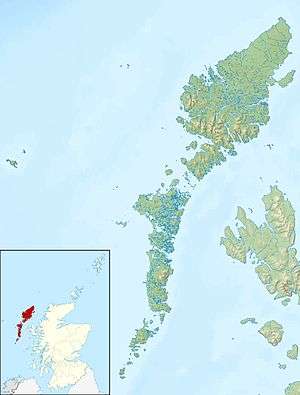Tahay
Tahay (Scottish Gaelic: Taghaigh) is an island in the Outer Hebrides of Scotland. The name originates from the Old Norse tagg-øy meaning island with a prominent hill. At 53 hectares (130 acres) in area and with a central peak of 65 metres (213 ft), it is the largest of the group of uninhabited islands off the north east coast of North Uist.
| Gaelic name | Taghaigh |
|---|---|
| Norse name | Tagg-øy |
| Meaning of name | island with a prominent hill |
| Location | |
 Tahay Tahay shown within the Outer Hebrides | |
| OS grid reference | NF965755 |
| Coordinates | 57.67°N 7.09°W |
| Physical geography | |
| Island group | Uists & Barra |
| Area | 53 ha (130 acres) |
| Area rank | 196= [1] |
| Highest elevation | 65 m (213 ft) |
| Administration | |
| Sovereign state | United Kingdom |
| Country | Scotland |
| Council area | Na h-Eileanan Siar |
| Demographics | |
| Population | 0 |
| References | [2][3][4] |
The island is used for sheep grazing and peat cutting.
History
In 1846, six families who had been evicted from their homes on Pabbay to make way for sheep, moved to the previously uninhabited island of Tahay. Although the island has no arable land, they hoped to make a living from fishing. However this proved too hard and they gave up the struggle in the 1850s and emigrated to Australia.[5]
Tahay is owned by the Scottish Government.
References
- Area and population ranks: there are c. 300 islands over 20 ha in extent and 93 permanently inhabited islands were listed in the 2011 census.
- 2001 UK Census per List of islands of Scotland
- Haswell-Smith, Hamish (2004). The Scottish Islands. Edinburgh: Canongate. ISBN 978-1-84195-454-7.
- Ordnance Survey
- "Overview of Tahay". Gazetteer for Scotland. Retrieved 2008-10-04.
| Wikimedia Commons has media related to Taghaigh. |
